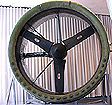![]()
The Aerospace Industry in Buffalo,
NY
Bell Aircraft in Buffalo, NY
1935-1960 Time Line and
25 Photographs from the Niagara Aerospace Museum taken in 2002
Special thanks to the staff of the Niagara Aerospace
Museum, especially Curator/Sr. Historian Richard Byron, for their cooperation and
assistance
Time Line below illustrations
Click on illustrations to enlarge and information
|
Major Reuben Fleet |
Consolidated's Vice President in charge of sales, Lawrence D. (Larry) Bell |
The P-39Q Airacobra in production in the Wheatfield plant in 1943. |
Detail of previous photo |
|
P-39Q Airacobra built at the Wheatfield plant. |
P-39Q Airacobra. |
P-39Q Airacobra |
The 47B-3 was the second model to be developed in 1947. |
|
The 47B-3 was the first commercially licensed helicopter |
The 47B-3 |
||
|
X-22A V/STOL. |
X-22A V/STOL |
X-22A V/STOL |
|
|
X-22A V/STOL |
X-22A propeller |
Rocket Belt |
Cold gas (nitrogen) pre-prototype of one-man Rocket Belt. |
|
Rocket Belt. |
GAM-63 "Rascal" Rocket |
The Rascal's engine |
Detail of previous photo. |
|
Detail of previous photo. |
Time Line
| 1924 | Major Reuben Fleet merges two out-of-state aircraft companies and establishes
the Consolidated Aircraft Company and moves it into the building Curtiss built
(and left at the end of WW1) at 2050 Elmwood Avenue in Buffalo. This followed a successful
career in the US Army where he learned to fly during WW1. In 1919, he was given the
job of starting the first US Air Mail Service with Army Corps pilots flying Curtiss
Jennys. Among the many airplanes Consolidated will develop (after the company left Buffalo) are the world famous PB2Y Catalina navy flying boat, the PT-1, PT-3, and XPY-1 "Admiral." |
| 1928 | Consolidated develops the "Huskie, Jr." for military and civilian
use. (These are also produced in Consolidated's Fort Erie plant.) Lawrence D. ("Larry") Bell joins Consolidated as Vice President in charge of sales. |
| 1935 | Consolidated moves to San Diego. Larry Bell, vice president and general manager for Consolidated, with the help of three associates from Consolidated, decides to found his own company in Buffalo . Bell's vision entails designing airplanes for the military that are designed around great firepower, rather than in the traditional method of adding firepower to airframe designs. With a 1936 contract, he begins with the YFM Airacobra, one of the many cutting edge designs by engineer Bob Woods. |
| 1940 | Bell Aircraft moves into a brand-new plant that the federal government helps finance for them in Niagara Falls, the Wheatfield plant. Bell employs 32,022 by the end of the year |
| 1941 | The Wheatfield plant produces Bob Woods' P-39 Airacobra. By the time
construction cease in 1944, 9588 will have been built. After combat experience with the Airacobra, an upgraded airframe, designated P-63 Kingcobra will succeed the Airacobra. Over 3600 will be built, most sent to the Russian front for close-support against Nazi armor. Bell employment will rise from 56 employees to 36,000 at the peak of war production. Bell begins helicopter development, setting up an experimental shop in Gardenville. |
| 1942 | Bell builds and flies the first American jet plane, the P-59 Airacomet. The P-59 is built in utmost secret on the upper floor of the old Ford (later Trico, now Tri-Main) plant on Main Street. It is then shipped to California via rail with a propeller attached to it as a disguise. |
| 1946 | The 47B is the first Bell helicopter model in production. The 47B3, the second model to be developed, is the first aircraft designed and produced by a manufacturer primarily for agricultural work. This "roadster" model had a full view open cockpit, easy access, rear view mirrors and small windshield that deflects the wind nicely. Further, the Bell Aircraft Co. designs and fabricates agricultural accessories for dusting and spraying. |
| 1947 | Bell develops several rocket-powered planes, beginning with the X-1, first aircraft to break the sound barrier when Chuck Yeager flies at 760 mph on October 14. |
| 1950s | A series of X aircraft are built: the X-1A, X-2 , and X-5. Many
of the workers who were laid off after the war are rehired. X-1 is designed to break the sound barrier. The X-2 is designed to fly twice the speed of sound. Two are built, but one is jettisoned into Lake Ontario when fire breaks out. The second plane fails to meet expectations. In the process, the test pilot is killed X-5 is the first adjustable-wing aircraft. The "Meteor" guided missile is also developed. |
| 1960s | The Aegina engine is developed for unmanned satellite launchings (still being
used in the new century because of reliability and low cost). Bell starts developing amphibious hovercrafts (still being used in the new century.) Bell Aircraft moves to Texas because of technological changes in the industry, management turnovers, and the high cost of manufacturing in New York State. |
























